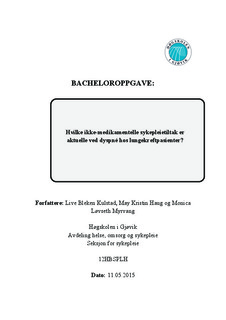| dc.contributor.author | Kulstad, Live Bleken | |
| dc.contributor.author | Haug, May Kristin Øvergaard | |
| dc.contributor.author | Myrvang, Monica Løvseth | |
| dc.date.accessioned | 2015-07-16T09:42:43Z | |
| dc.date.available | 2015-07-16T09:42:43Z | |
| dc.date.issued | 2015 | |
| dc.identifier.uri | http://hdl.handle.net/11250/293273 | |
| dc.description.abstract | NORSK: Introduksjon: Lungekreft er en av de vanligste kreftformer. Lungekreft er den krefttypen som krever mest
menneskeliv, og har svært dårlig prognose. I 2013 døde 2162 mennesker av lungekreft i Norge. Studier viser
at dyspné er et av hovedsymptomene hos pasienter med lungekreft.
Hensikt: Finne hvilke ikke-medikamentelle tiltak som er aktuelle hos lungekreftrammede pasienter med
dyspné når medikamentelle tiltak ikke er tilstrekkelig.
Metode: Oppgaven er en litteraturstudie. Den bruker både kvalitative og kvantitative forskningsartikler.
Aktuelle søkeord brukt er: “lung cancer, dyspnea, intervention, palliative care, lung neoplasms, treatment,
quality of life”.
Resultat: Funn i artiklene viser at dyspné har effekt på fysiske og psykiske faktorer, og kan gi redusert
livskvalitet, angst, depresjon, sosial isolasjon og begresninger i hverdagen. Det blir også vist at ulike ikkemedikamentelle
tiltak var nyttige.
Konklusjon: Medikamentell behandling av dyspné er ikke nok alene. Det er derfor viktig at sykepleier har
kunnskap om ikke-medikamentelle tiltak. Forskning viser at sammensatte tiltak som: pusteteknikker,
mestringsstrategier, psykososial støtte, informasjon og veiledning, og andre tiltak har vært nyttige for
lungekreftpasienter med dyspné. | nb_NO |
| dc.description.abstract | ENGLISH: Introduction: Lung cancer is one of the most common cancer types. Lung cancer is a very aggressive
and severe type of cancer, often with a limited rate of survival. In 2013, there where 2,162 cases of
mortality due to lung cancer in Norway. Studies have shown that dyspnea is one of the main symptoms in
patients with lung cancer.
Purpose: To find out which non-pharmacological interventions that are effective for patients with lung
cancer, when pharmacological interventions are not sufficient.
Method: This literature review considers evidence from both quantitative and qualitative research
articles. Examples of key words used to find articles were: “lung cancer, dyspnea, intervention, palliative
care, lung neoplasms, treatment, quality of life”.
Results: Dyspnea has been shown to have a negative effect on both physical and psychological factors,
such as: quality of life, anxiety, depression, social isolation, and limitations in everyday life. Studies
show that different non-pharmacological interventions are useful.
Conclusion: Pharmacological treatment alone is not enough in the management of dyspnea. Therefore it
is important that nurses has knowledge about non-pharmacological interventions. Research shows that
interventions such as: breathing techniques, coping strategier, psychosocial support, information and
guidance, and other measures, have been effective for lung cancer patients with dyspnea. | nb_NO |
| dc.language.iso | nob | nb_NO |
| dc.title | Ikke-medikamentelle tiltak ved dyspné hos lungekreftpasienter | nb_NO |
| dc.title.alternative | Non-pharmacological interventions for patients with lung cancer suffering with dyspnea | nb_NO |
| dc.type | Bachelor thesis | nb_NO |
| dc.subject.nsi | VDP::Medical disciplines: 700::Health sciences: 800::Nursing science: 808 | nb_NO |
| dc.source.pagenumber | 46 | nb_NO |
| dc.subject.keyword | lungekreft | nb_NO |
| dc.subject.keyword | dyspné | nb_NO |
